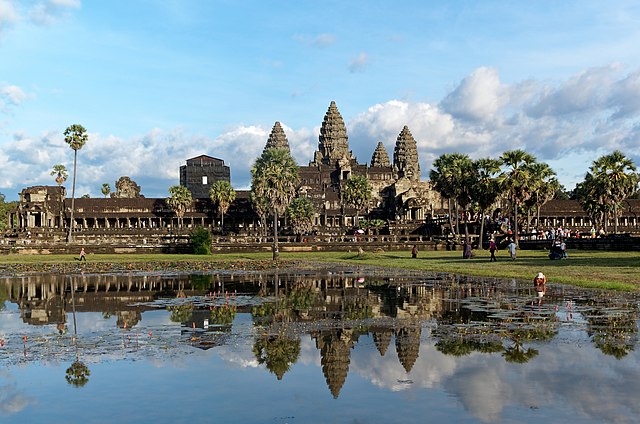
What is Angkor Wat? Angkor Wat is a temple complex in Cambodia. It is where the old capital of Cambodia used to be and it was a tomb. Angkor Wat is constructed of beautifully carved sandstone. There are thousands of images all over the walls, depicting figures from the Hindu and Buddhist religions.
The Angkor Wat temple complex is built on a rectangular island surrounded by a moat. The moat is 200 m wide. The whole area is 1,626,000 m2. It is inside the city of Angkor, which used to be the capital city of the Khmer Empire. The Khmer Empire used to be very large and it occupied the areas that are now Cambodia, Thailand, Laos, and a large section of Myanmar. The empire started in 781 and slowly faded away, disappearing entirely by the 15th century. Angkor Wat was built in 1150, when the Khmer Empire was at its peak. Angkor Wat means “temple city” in the Khmer language. Angkor is “city”, or capital city in this case, and “wat” means temple. It was far more than just a collection of monasteries.
Angkor Wat was built by Emperor Suryavarman II. Construction started in 1122, and the complex was finished in 1150, which is the year that Suryavarman II died. Suryavarman II is said to be the most powerful emperor of the Khmer Empire. He carried out several military campaigns, which increased the size of the empire, and he brought back a stable and powerful government. You can often tell how powerful a ruler is by what kind and how many buildings they build. Building monuments requires a ruler to find the materials, raise the labor, and have a stable enough country that it doesn’t get disrupted or destroyed by war. For example, Khufu, the pharaoh who built the Great Pyramid of Giza, was an extremely powerful ruler, and the buildings he was able to build have lasted for thousands of years. Suryavarman II is most famous for building Angkor Wat, although he built other buildings as well. Angkor Wat was built as a Hindu temple, and it was dedicated to the god Vishnu.
Suryavarman II died in 1150, probably on a military campaign, and it is thought that Angkor Wat was supposed to be his mausoleum, but he was never buried there. The reason people believe it was his tomb is that it is built pointing west, while most temples were built pointing east. This is symbolic of the sun setting, or life ending. All of the religious images inside the temple go from left to right, which is the opposite way to normal temples, and something that was done in funerals. After Suryavarman II died, the Khmer Empire was invaded by a neighboring kingdom, called the Cham. They were defeated by Jayavarman VII, who went on to become an even more powerful ruler than Suryavarman. He had many buildings and monuments built as well, but none of them were as impressive as Angkor Wat. In 1177, when the temple was only 27 years old, Jayavarman switched it from a Hindu temple to a Buddhist one, and it has remained Buddhist ever since.
Angkor Wat was a Buddhist temple, but it was so much more than that. It was an important part of a city that has long since disappeared. Angkor was the capital city of the Khmer Empire, and it had over a million people shortly after Angkor Wat had been built. There were many farmers, workers, and a large religious community. There were a large number of buildings, as you would expect with over a million people, but only the temples were built of sandstone. All of the other buildings were made of wood and other similar materials. In 1431, the Khmer Empire was invaded, and the capital city was moved to the south. People left and all of the wooden buildings fell down and biodegraded. Only the temples, such as Angkor Wat, and the roads and marks of the city were left.
Angkor Wat was rediscovered by the French when they colonized Cambodia, and they tried to restore the temple. Buddhist monks had been living in and near the temple for centuries, but the temple was in a poor state of repair. Art and statues had been stolen and natural disasters had broken many of the buildings. The French started repair work and it has taken a long time but the temples have slowly been returned to their original beauty. They were made a world heritage site and now have state protection. The site of the temples is supposed to be awe inspiring, but over two million people visit them every year, so that might put a damper on the amount of awe. And this is what I learned today.
Sources
https://www.history.com/topics/landmarks/angkor-wat
https://en.wikipedia.org/wiki/Suryavarman_II
https://www.angkorwattraveltours.com/blog/angkor-wat-the-world-wonder
https://asiasociety.org/education/legacy-angkor
https://en.wikipedia.org/wiki/Ya%C5%9Bodharapura
https://en.wikipedia.org/wiki/Khmer_Empire
https://en.wikipedia.org/wiki/Angkor
https://en.wikipedia.org/wiki/Angkor_Wat
https://en.wikipedia.org/wiki/Khmer_architecture#Temple_mountain
https://en.wikipedia.org/wiki/Jayavarman_VII
Image By Jakub Hałun – Own work, CC BY-SA 4.0, https://commons.wikimedia.org/w/index.php?curid=77167148

Pingback: #930 Why is there an obelisk in Rome?